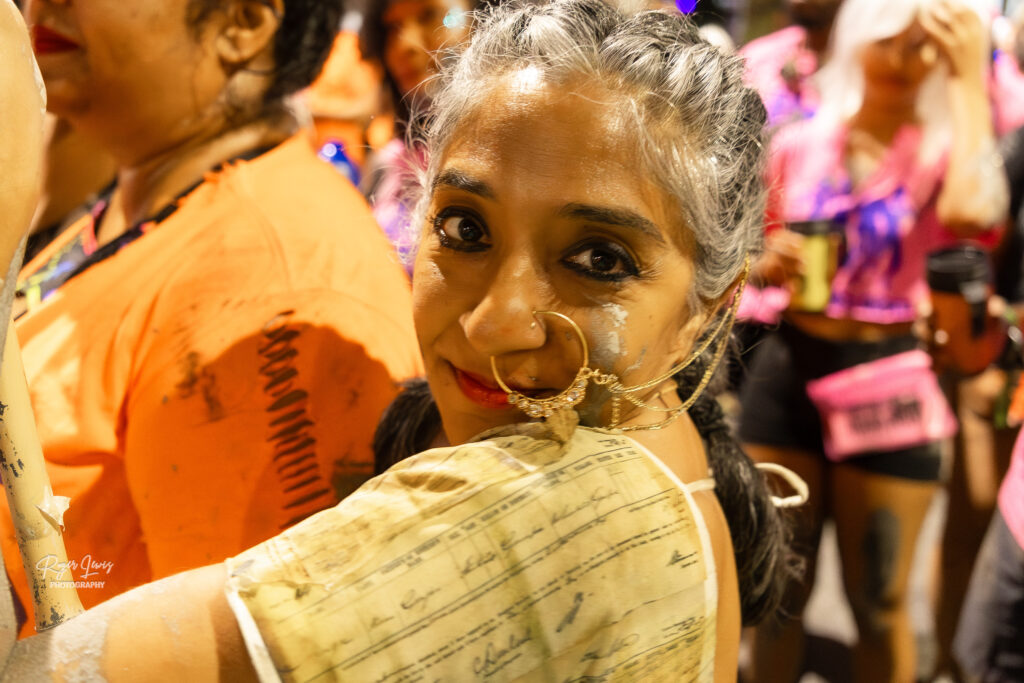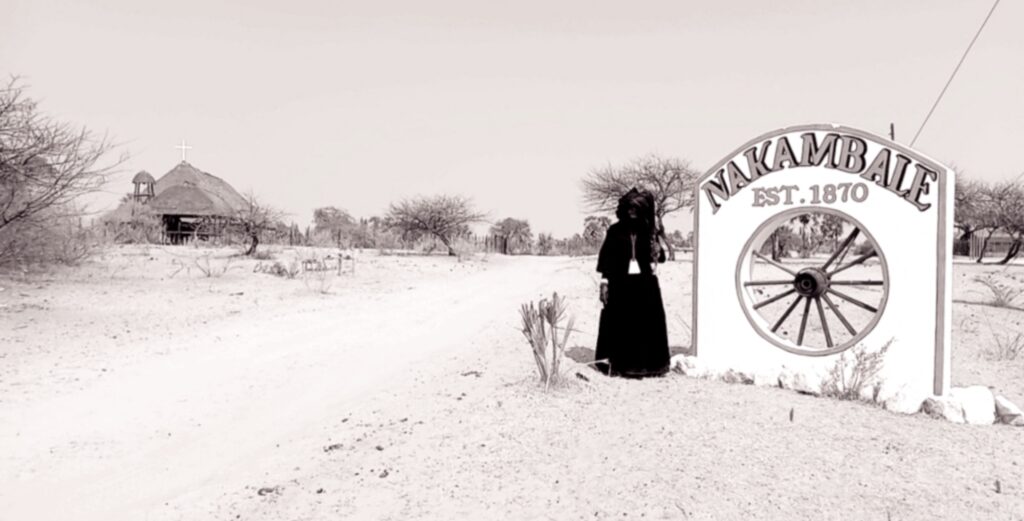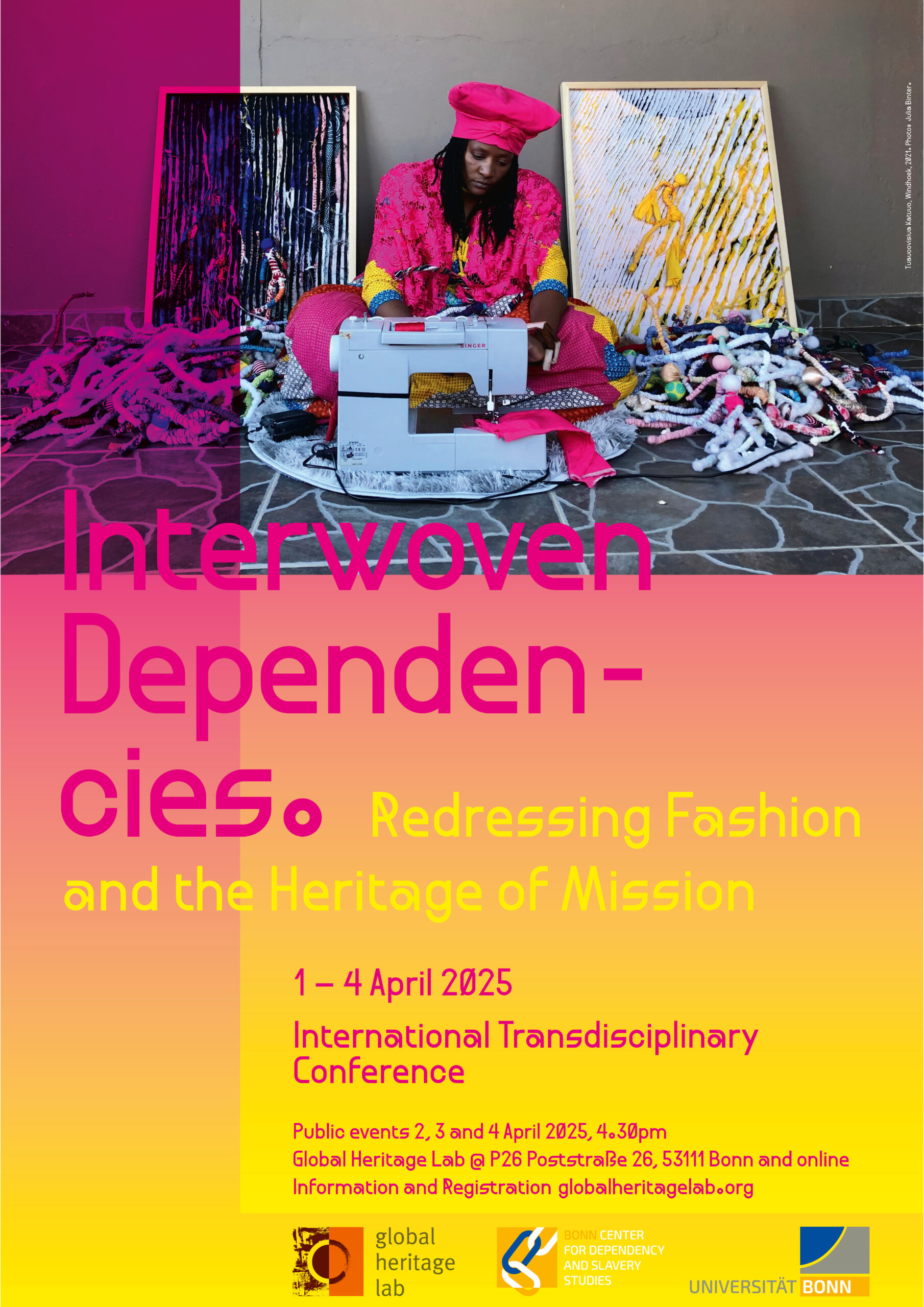Interwoven Dependencies
Redressing Fashion and
the Heritage of Mission
1 – 4 April 2025
 By Jun.-Prof. Dr. Julia Binter
By Jun.-Prof. Dr. Julia Binter
How has Christian missionization shaped fashion in Africa, the Americas, and the Caribbean? How do scholars, artists, and designers engage with this legacy today? This international conference brings together researchers from diverse fields—including History, Anthropology, Art History, Gender Studies, Fashion Studies, Heritage Studies, and Literary Studies—alongside artists working in performance, installation, textile art, jewellery, and poetry. Together, they explore these questions through transdisciplinary perspectives. They examine the experiences and contributions of women and children in contexts of religious contact and conflict, considering the body as both an archive and a site of identity formation. Through the practices of making and wearing clothing and jewellery, participants critically reflect on missionary influence, as well as acts of adaptation, resistance, and resilience.
International transdisciplinary conference with
Delali Ayivi – Togo/UK, fashion photographer
Sela Adjei – Ghana, scholar (African studies) and artist (print, drawing)
Osusuua Adwoa Bobie – Ghana, scholar (Fashion and Gender Studies)
Steeve Buckridge – Jamaica/USA, scholar (History)
Nicholas d’Ornellas – USA/Guyana, artist (printmaking and weaving)
Sofía Magdits Espinoza– Germany/Peru, artist (weaving, performance)
Gabrielle Hosein – Trinidad and Tobago, scholar (Gender Studies) and artist (performance)
Tuauoovisiua Katuuo – Namibia, multidisciplinary textile artist and designer
Sinah Kloß – Germany, scholar (Anthropology of the Americas)
Dandara Maia – Germany/Brazil, scholar (African Studies)
Tuli Mekondjo – Namibia, artist (mixed-media, performance)
Yohannes Mulat Mekonnen – Germany/Ethiopia, scholar (visual anthropology) and art (film, painting)
Cheryl McIntosh – Germany/Jamaica, artist (mixed-media)
Amanda T. McIntyre, Trinidad and Tobago, scholar (Cultural Studies) and artist (writing, costume design, installation, and performance)
Franziska Moosmann – Germany, scholar (Catholic Theology and Cultural Anthropology)
Loo Nascimento – Brazil, jewelry designer
Pia Wiegmink – Germany, Scholar (Literary and Cultural Studies)
Organised by
Julia Binter – Critical Museum and Heritage Studies, University of Bonn, Maria Caley – Visual Arts, University of Namibia, Loini Iizyenda – Visual Arts, University of Namibia, Malika Kraamer – Cultural History, University of Bonn, Gisela Muschiol – Catholic Theology, University of Bonn, Karoline Noack – Anthropology of the Americas, University of Bonn
Funded by
Bonn Centre for Dependency and Slavery Studies, Global Heritage Lab
Public Events
Wednesday, 2 April 2025, 4.30pm
Keynote address
Dr. Gabrielle Hosein
Nachorious: The Nach Gyal as Post Indenture Caribbean Feminist Jouvay Mas
Venue: Global Heritage Lab at P26, Poststraße 26, 53111 Bonn and online
Please register for onsite attendance: https://lmy.de/sNIdk
Please register for online attendance: https://lmy.de/jidWq
This mas commemorates 180 years of the Indian ‘nautch girl’ – dancer, courtesan, tawa’if, devadasi, widow, bazaar woman, and rand or randi prostitute or sex worker – escaping British imperialism, dispossession, criminalization, evangelism, political punishment and impoverishment through the journey of indenture. Stereotyped as notoriously immoral and sexually loose, the indentured Indian woman was considered a threat to the system itself. Remembered through the character of the nach gyal, Nachorious, she still dances in the spirit of freedom and resistance. This Jouvay mas is made with indenture records from 1867, text from Mahadai Das poetry and scholarship on the nautch girl, a nach gyal figure whose spinning in the air will be a dance of life, and ghungroos to sonically memorialize this history as it became ours in the Caribbean.

“Playing Nachorious, a nach gyal mas, in Trinidad’s Jouvay”, Photo: Roger Lewis, 2025.
Dr. Gabrielle Jamela Hosein is Senior Lecturer, Institute for Gender and Development Studies, The University of the West Indies, St. Augustine.
Thursday, 3 April 2025, 4.30pm
Roundtable Discussion
Interwoven Dependencies. Redressing Fashion and the Heritage of Mission
With participants of the conference
Moderator: Prof. Dr. Pia Wiegmink (BCDSS)
Venue: Global Heritage Lab at P26, Poststraße 26, 53111 Bonn and online
Please register for onsite attendance: https://lmy.de/ZNIOM
Please register for online attendance: https://lmy.de/iMgsY
Christian missionaries pressured women in colonial contact zones to dress more ‘appropriately’ according to European understandings of Christian modesty. At the same time, access to new material goods was one of the attractions to convert. New converts and missionaries actively negotiated the re-composition of local and European fashion styles and, related to this, new forms of body and gender norms and identities. The recomposed forms of dress evolved constantly, gradually acquiring the status of ‘traditional’ dress and becoming materialisations of cultural identity and belonging. Yet, against the backdrop of postcolonial critique and the latest decolonization movements worldwide, the perception of these on-going fashions is currently shifting and being questioned as part of colonial legacies. Given these historical processes, how can we rethink dress and fashion not only as cultural expressions but also as archives of lived experiences, contestations, and resistances? This roundtable discussion brings together scholars and artists to explore these questions and unlock the transdisciplinary potential of dialogue between the arts and academia.

Tuauoovisiua Katuoo, Windhoek 2021. Photo: Julia Binter.
Friday, 4 April 2025, 4.30pm
Keynote Performance
Tuli Mekondjo
Saara Omulaule: Black Saara
Followed by a discussion with Maria Caley, Loini Iizyenda, University of Namibia, and Tuauoovisiua Katuoo, artist, Namibia
Venue: Global Heritage Lab at P26, Poststraße 26, 53111 Bonn and online
Please register for onsite attendance: https://lmy.de/gVDpi
Please register for online attendance: https://lmy.de/uaMlK
Tuli Mekondjo’s performance Saara Omulaule/Black Saara (2023) was improvised immediately after reading Kari Miettinen’s book On the Way to Whiteness – Christianization, Conflict, and Change in Colonial Owamboland, 1910-1965. The Finnish Sunday school song about “Black Saara – the little Negro girl” prompted a visceral response and an avenue of questioning for Mekondjo. She asks: “What made my ancestors (Aawambo people) convert to Christianity during the period 1910-1965?” The artwork evokes the need for ritual practices on living bodies as an attempt to awaken their souls from spiritual death in order to connect to our ancestors. This practice insists on the imperative performative action carried forward by ancestors, whose remains are still kept in the bondage of colonially created museums and missionary-made cemeteries. Mekondjo’s use of food, ritual and medicinal items to install the performance video are a way to connect ancestral spirits with the digital manifestation. So too does the use of organic materials signify a new growth with organic synthesis. PW: olukonda

Tuli Mekondjo, Saara Omulaule/Black Saara, 2023. Photo: Courtesy by the artist.
Tuli Mekondjo (b. 1982, Kwanza-Sul, Angola) is a mixed-media artist, exploring the construction of identity politics in the shadow of Namibia’s violent past as both a German and later South African colony. She is recipient of the Villa Romana Prize 2024.

